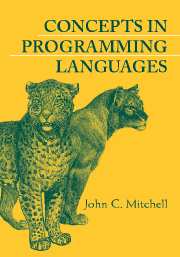Book contents
- Frontmatter
- Contents
- Preface
- Part 1 Functions and Foundations
- Part 2 Procedures, Types, Memory Management, and Control
- Part 3 Modularity, Abstraction, and Object-Oriented Programming
- 9 Data Abstraction and Modularity
- 10 Concepts in Object-Oriented Languages
- 11 History of Objects: Simula and Smalltalk
- 12 Objects and Run-Time Efficiency: C++
- 13 Portability and Safety: Java
- Part 4 Concurrency and Logic Programming
- Appendix A Additional Program Examples
- Glossary
- Index
13 - Portability and Safety: Java
from Part 3 - Modularity, Abstraction, and Object-Oriented Programming
Published online by Cambridge University Press: 05 June 2012
- Frontmatter
- Contents
- Preface
- Part 1 Functions and Foundations
- Part 2 Procedures, Types, Memory Management, and Control
- Part 3 Modularity, Abstraction, and Object-Oriented Programming
- 9 Data Abstraction and Modularity
- 10 Concepts in Object-Oriented Languages
- 11 History of Objects: Simula and Smalltalk
- 12 Objects and Run-Time Efficiency: C++
- 13 Portability and Safety: Java
- Part 4 Concurrency and Logic Programming
- Appendix A Additional Program Examples
- Glossary
- Index
Summary
The Java programming language was designed by James Gosling and others at Sun Microsystems. The language, arising from a project that began in 1990, was originally called Oak and was intended for use in a device affectionately referred to as a set-top box. The set-top box was intended to be a small computational device, attached to a network of some kind, and placed on top of a television set. There are various features a set-top box might provide. You can imagine some of your own by supposing that a web browser is displayed on your television set and, instead of a keyboard, you click on icons by using some buttons on your remote control. You might want to select a television program or movie or download a small computer simulation that could be executed on the computational device and displayed on your screen. A television advertisement for an automobile might allow you to download an interactive visual tour of the automobile, giving each viewer a personalized simulation of driving the car down the road. Whatever scenario might appeal to you, the computing environment would involve graphics, execution of simple programs, and communication between a remote site and a program executed locally.
At some point in the development of Oak, engineers and managers at Sun Microsystems realized that there was an immediate need for an Internet-browser programming language, a language that could be used to write small applications that could be transmitted over the network and executed under the control of any standard browser on any standard platform.
- Type
- Chapter
- Information
- Concepts in Programming Languages , pp. 384 - 428Publisher: Cambridge University PressPrint publication year: 2002



